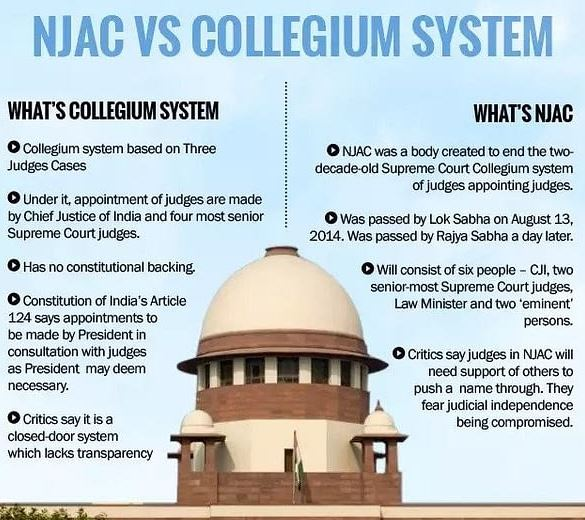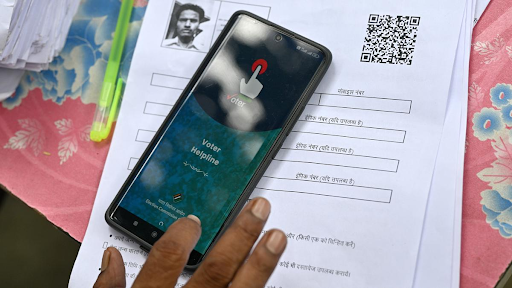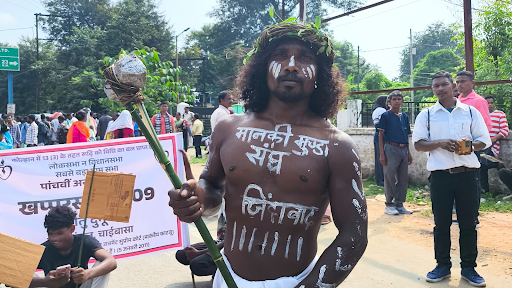Description

Copyright infringement not intended
In News
- The Supreme Court of India has linked the Court verdict on National Judicial Appointments Commission (NJAC) with the delaying Collegium recommendations from the government’s side.
- In 2015, The Supreme Court struck down the NJAC, which was supposed to give the government an equal say in judicial appointments to the constitutional courts.
- The Supreme Court bench stated that “There appears to be an unhappiness in the government of the fact that NJAC did not muster the constitutional mandate… That cannot be the reason to not comply with the law of the land,”.
- The statement marked a new high in the increasing tensions between the judiciary and the government over appointments.
- The Union Law minister has been criticising the Collegium system in several public forums.
- The Supreme Court responded by accusing the government of using silence and inaction to delay appointments to the constitutional courts.
- The court accused the government of picking and choosing names from the Collegium list, this destroys the seniority. The Collegium while sending names keeps many factors in mind.
- The court said 20% of the judicial posts in High Courts were vacant.
National Judicial Appointments Commission (NJAC)
- The National Judicial Appointments Commission (NJAC) was established by the 99th constitutional amendment Act, of 2014.
- The Commission was supposed to be responsible for the recruitment, appointment and transfer of judicial officers, legal officers and legal employees under the Union government and all state governments.
- The NJAC was supposed to replace the collegium system for the appointment of judges.
- The Commission would have consisted of the following 6 persons:
- Chief Justice of India (Chairperson).
- Two other senior judges of the Supreme Court.
- The Union Minister of Law and Justice.
- Two eminent persons: These 2 eminent persons would have been nominated by a committee consisting of the;
- Chief Justice of India
- Prime Minister of India
- Leader of Opposition in the Lok Sabha (or where there is no such Leader of Opposition, then, the Leader of the single largest Opposition Party in Lok Sabha).
- Appointment of Chief Justice of India: The NJAC shall recommend the seniormost judge of the Supreme Court for appointment as Chief Justice of India.
- Appointment of Supreme Court judges: The NJAC shall recommend names of persons based on their ability, merit and other criteria specified in the regulations.
- The veto power of members: The NJAC shall not recommend a person for appointment if any two of its members do not agree to such recommendation.
- The President has the power to ask NJAC to reconsider their recommendations. However, if the NJAC makes a unanimous decision while reconsidering, then the President has to make the appointment as per the NJAC’s recommendations.
- In October 2015, the Constitution Bench of the Supreme Court by a 4:1 majority struck down the NJAC as unconstitutional and upheld the collegium system.

Collegium System
- Under the Collegium System, appointments/elevation of judges/lawyers to the Supreme Court and transfers of judges of High Courts and Apex Court are decided by a panel of the Chief Justice of India and the four senior-most judges of the Supreme Court.’
- The word ‘Collegium’ is nowhere mentioned in the Indian Constitution, it has come into force as per Judicial Pronouncement.
Evolution of Collegium System
- Under the Constitution, The Judges of the Supreme Court are appointed by the president. The chief justice is appointed by the president after consultation with such judges of the Supreme Court and high courts as he deems necessary.
- The other judges are appointed by the president after consultation with the chief justice and other judges of the Supreme Court and the high court as he deems necessary.
- Consultation with the chief justice is obligatory in the case of the appointment of a judge other than the Chief justice
- First judges case (1982): The Supreme court held that consultation does not mean agreement and it only means an exchange of views.
- Second judges case (1993): The court changed its earlier ruling and changed the meaning of the word consultation to consensus.
- It ruled that the advice tendered by the CJI is binding on the President in matters of appointment of SC judges. But any such advice would be tendered after CJI consults with two of his most senior judges.
- Third judges case (1998): The consultation process should be based on the plurality of judges.
- CJI should consult a Collegium of four senior-most judges before making a recommendation to the President and even if two judges give an unfavourable opinion, he should not send the proposal to the President.

Way Forward
● The Collegium System is Criticised mainly due to the lack of transparency, Lack of Consensus among members, and Delay in Judicial appointments.
● The Court has taken several steps in promoting transparency in judicial appointments, such as recently the Court’s collegium decide to published a resolution promising to make public, on the court’s website, its various decisions, including its verdicts on persons nominated for elevation as judges to the high courts, its choices of candidates for elevation to the SC, and its decisions on transfer of judges between different High Court.
- Judicial reform is the need of the hour as the limited supply of judges to cater for the vast demand for the attention of the courts by accumulating the cases has led to rising in the figurative price of justice.
Must Read: https://www.iasgyan.in/daily-current-affairs/judicial-appointments
https://epaper.thehindu.com/Home/ShareArticle?OrgId=GMKAIPNJM.1&imageview=0
https://t.me/+hJqMV1O0se03Njk9













